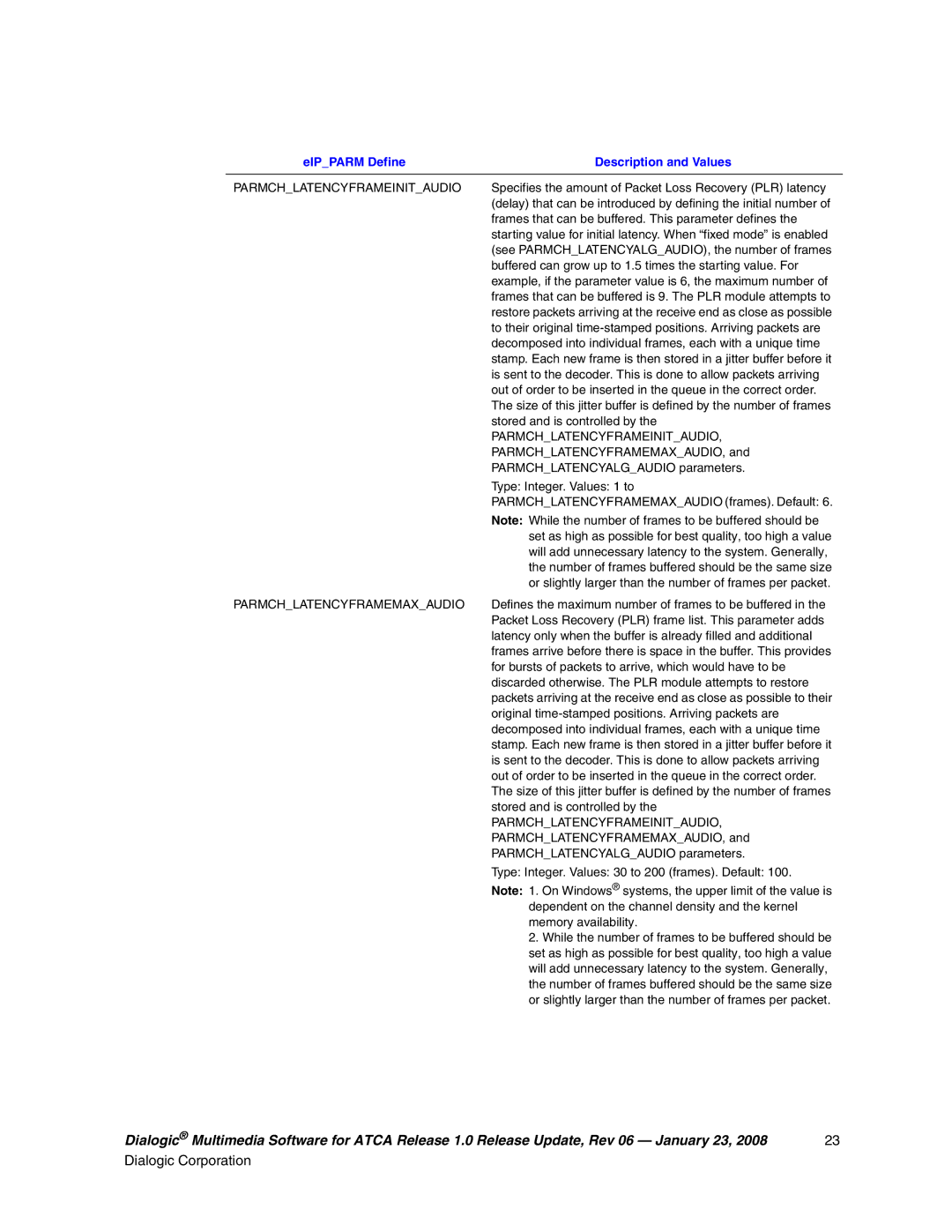eIP_PARM Define | Description and Values |
|
|
PARMCH_LATENCYFRAMEINIT_AUDIO | Specifies the amount of Packet Loss Recovery (PLR) latency |
| (delay) that can be introduced by defining the initial number of |
| frames that can be buffered. This parameter defines the |
| starting value for initial latency. When “fixed mode” is enabled |
| (see PARMCH_LATENCYALG_AUDIO), the number of frames |
| buffered can grow up to 1.5 times the starting value. For |
| example, if the parameter value is 6, the maximum number of |
| frames that can be buffered is 9. The PLR module attempts to |
| restore packets arriving at the receive end as close as possible |
| to their original |
| decomposed into individual frames, each with a unique time |
| stamp. Each new frame is then stored in a jitter buffer before it |
| is sent to the decoder. This is done to allow packets arriving |
| out of order to be inserted in the queue in the correct order. |
| The size of this jitter buffer is defined by the number of frames |
| stored and is controlled by the |
| PARMCH_LATENCYFRAMEINIT_AUDIO, |
| PARMCH_LATENCYFRAMEMAX_AUDIO, and |
| PARMCH_LATENCYALG_AUDIO parameters. |
| Type: Integer. Values: 1 to |
| PARMCH_LATENCYFRAMEMAX_AUDIO (frames). Default: 6. |
| Note: While the number of frames to be buffered should be |
| set as high as possible for best quality, too high a value |
| will add unnecessary latency to the system. Generally, |
| the number of frames buffered should be the same size |
| or slightly larger than the number of frames per packet. |
PARMCH_LATENCYFRAMEMAX_AUDIO | Defines the maximum number of frames to be buffered in the |
| Packet Loss Recovery (PLR) frame list. This parameter adds |
| latency only when the buffer is already filled and additional |
| frames arrive before there is space in the buffer. This provides |
| for bursts of packets to arrive, which would have to be |
| discarded otherwise. The PLR module attempts to restore |
| packets arriving at the receive end as close as possible to their |
| original |
| decomposed into individual frames, each with a unique time |
| stamp. Each new frame is then stored in a jitter buffer before it |
| is sent to the decoder. This is done to allow packets arriving |
| out of order to be inserted in the queue in the correct order. |
| The size of this jitter buffer is defined by the number of frames |
| stored and is controlled by the |
| PARMCH_LATENCYFRAMEINIT_AUDIO, |
| PARMCH_LATENCYFRAMEMAX_AUDIO, and |
| PARMCH_LATENCYALG_AUDIO parameters. |
| Type: Integer. Values: 30 to 200 (frames). Default: 100. |
| Note: 1. On Windows® systems, the upper limit of the value is |
| dependent on the channel density and the kernel |
| memory availability. |
| 2. While the number of frames to be buffered should be |
| set as high as possible for best quality, too high a value |
| will add unnecessary latency to the system. Generally, |
| the number of frames buffered should be the same size |
| or slightly larger than the number of frames per packet. |
Dialogic® Multimedia Software for ATCA Release 1.0 Release Update, Rev 06 — January 23, 2008 | 23 |
Dialogic Corporation |
|
